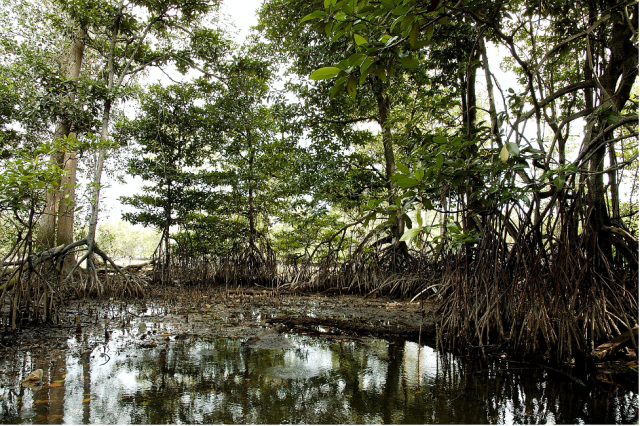Mangroves Help Fight Climate Change, Support Other Biodiversity Areas

- By Cambodianess
- July 26, 2021 4:24 PM
Today, the ASEAN Centre for Biodiversity (ACB) joins the rest of the world in celebrating the International Day for the Conservation of the Mangrove Ecosystem, which is observed each year to raise awareness of the importance and benefits of protecting the world’s most productive ecosystems.
Mangroves in the ASEAN are rich and diverse, armouring communities against the cruel impacts of climate change and, at the same time, underpinning community livelihoods as well as economies. The region hosts 42 per cent of mangrove forests in the world, with an estimated total area of 42,914 square kilometres as of 2020. At least 47 out of the 70 known mangrove species in the world can be found in the region, according to the database of the ASEAN Clearing House Mechanism.
It is worthy to note how crucial these ecosystems are in supporting the interconnectivity of key biodiversity areas. As they link the land and the sea, mangrove systems receive nutrients and organic matter from terrestrial ecosystems, estuaries, and marine systems. These nutrient-rich ecosystems serve as habitats for land animals and nesting and breeding areas for fish and shellfish, migratory birds, and sea turtles. The benefits arising from mangrove ecosystems extend to nearby ecosystems such as fisheries. By serving as nursery habitats, mangrove areas allow key marine species to thrive before moving to other areas as they mature.
In Thailand, for instance, the Ao Phang Nga-Mu Ko Surin- Mu ko Similan National Park, a designated ASEAN Heritage Park (AHP), has one of the country’s most extensive and best-preserved mangrove forests that support marine species like the critically endangered black finless porpoise and green sea turtles.
Apart from cleaning and filtering out pollutants from the water before it reaches the ocean, mangroves’ sturdy root systems form a natural barrier against storm surges and floods.
Similarly, several studies show that the movement and exchange of organic carbon among ecosystems support the networks of coastal ecosystems that release and trap carbon and nutrient from adjacent ecosystems. With their high carbon sequestration and storage capacity, mangrove systems, along with seagrass and coral reefs, are considered tools for climate change mitigation.
These valuable contributions to climate mitigation and adaptation and the people’s welfare are enough reasons for us to do more to protect these ecosystems. At this point, amid the more frequent and intense climate-related disasters coming our way, actions to integrate biodiversity considerations into programmes and policies are even more dire and urgent. Biodiversity and climate change issues are interdependent and should not be tackled separately.
Over the years, we have seen the decline of mangroves, losing over 26 per cent of all mangroves in the ASEAN region alone from 1980 to 2005, largely due to human-driven activities, such as logging and conversion to other uses. The first step to address the loss of mangroves is to assess and appreciate the true value of mangrove systems. Taking into account the opportunity costs of losing nature brings us closer to the best possible solution for our present woes.
At the regional and national levels, there are increasing efforts to protect and restore mangroves and other crucial ecosystems. In Brunei Darussalam, the government is paying close attention to widening the coverage of its mangroves and peat swamp forests in the development of its national biodiversity strategies and plans. To quote the statement of Dr. Nor Imtihan Binti Haji Abdul Razak, permanent secretary for planning, land use, and environment of Brunei Darussalam’s Ministry of Development, and chair of the ASEAN Senior Officials on the Environment during an online event recently led by the ACB: “every decision made for development requires consideration for nature and biological resources.”
This August, the ACB, together with the ASEAN Secretariat, will formally launch the ASEAN Green Initiative, which aims to plant and grow 10 million native trees in 10 years across the region. The initiative, which is in line with the UN Decade on Ecosystem Restoration, encourages the use of local species and the active participation of the community and local experts to ensure that ecosystems are effectively restored to their healthy and stable state.
Indeed, the role of communities to protect mangroves is important. The ACB continues to support civil society organisations through the Small Grants Programme, in cooperation with the German Development Bank (KfW) in enabling communities to restore and protect ecosystems and improving livelihood opportunities. One of the programme’s sites is a designated AHP, Meinmahla Kyun Wildlife Sanctuary, an extensive mangrove forested island. The project is ongoing despite some setbacks due to the COVID-19 pandemic.
I am likewise pleased that biodiversity and nature-based solutions are high on the agenda of the ASEAN Member States based on earlier pronouncements made, including more recently at the online event co-convened by the ACB and the United Kingdom COP26 Presidency.
On this occasion, let us take this opportunity to motivate each other to work closely together and step up efforts for the protection of nature's marvels, for we are part of nature. #WeAreASEANBiodiversity!
Happy International Day for the Conservation of the Mangrove Ecosystem!
Dr. Theresa Mundita S. Lim is Executive Director of ASEAN Centre for Biodiversity















